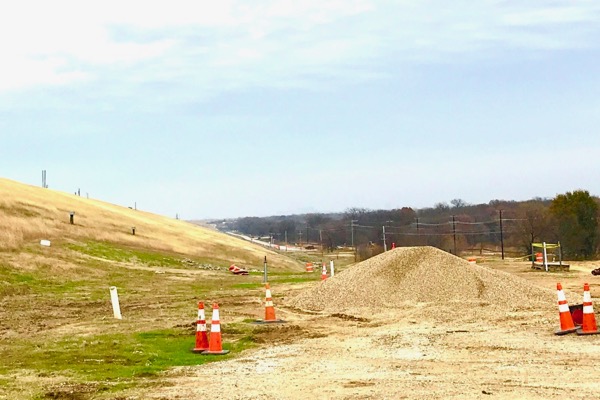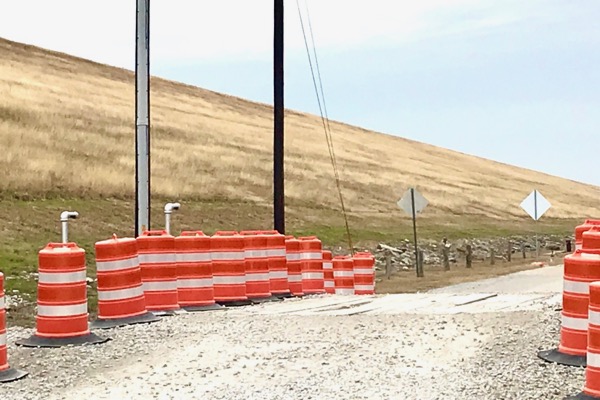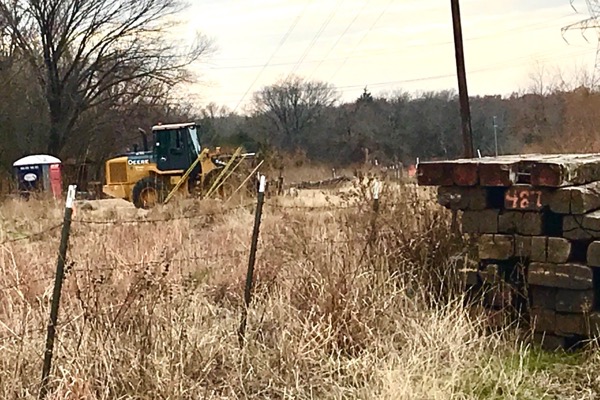
The demise of Lake Lewisville dam has been greatly exaggerated, says GSDFW reporter. Above, monitoring stations line the dam. Photos by Amy Martin.
 Dec. 10, 2019
Dec. 10, 2019
You may have heard the rumors running through the North Texas grapevine:
“The Lake Lewisville dam is about to fail.”
Well, no.
“A sand boil is eroding the dam from within.”
Not really.
“It’s one of the top ten worst dams in America.”
Again, no.
So what’s going on with the Lake Lewisville dam? And how will this affect Lake Lewisville Environmental Learning Area that takes up 2,000 acres at its base?
Media reports from the past few years might lead you to think much of Dallas was in danger of being inundated at any time. In 2015, the Dallas Morning News reported the dam was one of the country's most dangerous and a breach could put 431,000 people in harm’s way
Here’s the scoop:
• All earthen embankments allow some water to seep through.
• Lake Lewisville dam has some serious seepage issues.
• Its seepage issues are repairable and maintainable.
• Impact to LLELA from repairs will be minimal.
Lewisville Lake (formerly called Lake Dallas) is enormous: two-million acre-feet [water needed to cover an acre one foot deep] containing 2.5 billion tons of water. The 63-year-old earthen dam that creates it is six miles long and up to 125 feet high containing 13.21 million cubic yards of fill. And it’s over six decades old, finished in 1955. There are two seepage areas in the dam that the USACE has been monitoring for years.
“The concern that’s driving the risk assessment are the consequences: the number of people and the amount of investment in property and infrastructure that’s downstream of the dam,” says Stacy Gray, U.S. Army Corps of Engineers project manager for the Lewisville Lake Dam Safety Modifications.
“What we're trying to do as responsible dam owners is to get that probability of failure as low as we possibly can and we're doing that by improving our existing seepage collection systems.“
Those who work at LLELA in proximity to the dam remain confident.
“I will say that I'm not worried about the safety or the integrity of the dam,” says LLELA restoration manager Richard Freiheit.
 MONITORING DAM HEALTH
MONITORING DAM HEALTH
Initial dam repairs entail embankment modifications to reduce seepage and enable more stringent monitoring, plus general modernizing.
“Three berms are going in,” says Gray. “Two of those will be over the seepage collection systems and one of them is upstream of the dam to basically restore a berm is been eroded away over time. These help us make sure that the seepage coming through the dam goes into the collection systems.”
In the typical passage of rainwater through an earthen dam, it’s essential to move through without dissolving any of the soil that can lead to dam instability.
“We've got three different filters going in: filters in two seepage areas and one at the end of the outlet works [where the Elm Fork emerges from the lake],” says Gray.
“As long as clear water is coming through [the seepage-area filters], that tells us that the materials in the embankment are still in the embankment. If it stops being clear water, we become concerned. Is that material from runoff over the embankment itself, or is that material from inside the embankment being pushed through?“
Visitors to LLELA will notice additional vertical pipe-like structures in the dam slope where the entry road approaches and veers away from the embankment. They are more numerous than before and more substantial due to automatic monitoring equipment.
“That’s instrumentation that we use to continue to monitor the health of the dam,” says Gray. “It ensures that we can appropriately monitor the amount of seepage which is coming out and understand where it’s coming from and make sure that that the seepage is not moving any of the materials in the embankment.”
 ENORMOUS DAM, ENORMOUS EQUIPMENT
ENORMOUS DAM, ENORMOUS EQUIPMENT
Another change already visible to LLELA visitors is widening the entry road corridor, which resulted in the loss of some trees. A second parallel haul road is being constructed for dump trucks carrying massive loads of construction material.
“We're concerned about the safety of our recreational users with those huge trucks hauling big rocks and all that dirt,” says Gray, so the two roads will be separated.
In the area east of the outlet works, the roadway is much more constrained.
“Once we start running the construction, we can not allow access to some areas,” says Gray. “Starting in January, there will be no access past the outlet works. Access to Bittern Marsh Trail [east of the outlet works] will be closed, though personnel will still be able to get in to do maintenance.”
Toward the spring, access will be pushed further back to the Cicada Pavillion and there will be no access to Elm Fork at the outlet works — a sad day for fans of fishing.
“People really need to stay out of that area during this construction phase for their safety,” says Gray. “We’re worried about materials falling off the trucks and injuring someone.”
LLELA access restrictions will last about a year. To keep up with the latest developments, check the LLELA website‘s Current Trail, Paddling, and Camping Conditions page.
 THE DAM PLAN
THE DAM PLAN
The Lewisville Lake Dam Safety Modifications is a $150 million project, split into three phases:
Embankment modifications and improvements in seepage collection and monitoring.
Improvements to the dam’s spillway on the far eastern end.
Remediation of the haul road and borrow pits providing dirt for dam berms.
“Right now, we're estimating spring of 2021 for completion of construction of the first phase,” says Gray.
Once complete, access at LLELA will return to pre-construction conditions plus vital habitat improvements.
“One part will be a determination of desired ecosystems that will be put back after completion of dam modifications,” says LLELA restoration manager Richard Freiheit. “For a majority of the haul road, prairie is the obvious goal.”
“The Corps is working with us to construct what will be a functional ephemeral wetland in the wake of the resulting borrow pits left from the construction, “ says Dr. Kenneth Steigman, director of LLELA. “We are working with Lewisville Aquatic Ecosystem Research Facility (LAERF) staff in developing the seeding and planting species to be utilized in the construction areas.”
“I think that there is general agreement that the restoration plan for the borrow pit area will produce much higher quality wildlife habitat than is currently present in this low diversity, early successional woody forest if the plan is completed.”
Stay up to date on everything green in North Texas, including the latest news and events! Sign up for the weekly Green Source DFW Newsletter! Follow us on Facebook and Twitter. Also check out our new podcast The Texas Green Report, available on your favorite podcast app.









